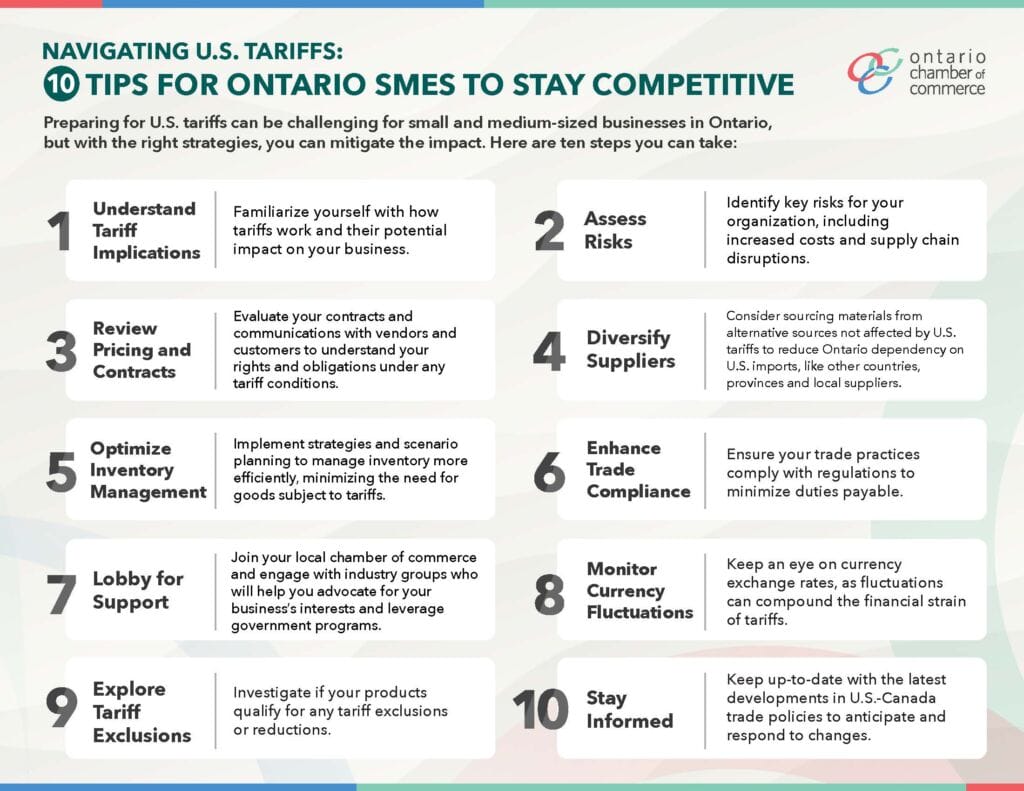Business Resources
This member exclusive resource is being offered to the entire business community compliments of the members of the Halton Hills Chamber of Commerce.
To learn more about the benefits of our Chamber community, please visit here.
Standing Strong Halton Hills Tariff Support
The Halton Hills Chamber of Commerce: Empowering Our Business Community
The Halton Hills Chamber of Commerce is dedicated to strengthening our business community. In response to potential tariffs and trade challenges that could impact our local economy, we offer this page as a resource during economic uncertainty.
Through strategic advocacy, industry insights, and networking opportunities, we are championing policies that support local businesses, foster collaboration, and strengthen Halton Hills’ economy.
Connect with us to share tariff impacts on your business.
Together, we can tackle today’s challenges and build a stronger, more resilient business community.

Latest Developments:
- Mar 26, 2025 5:34 PM EST | Trump going ahead with tariffs on autos starting next week
- Mar 12, 2025 10:45 AM EST | Canada hits the U.S. with tariffs on $29.8B worth of goods after trump slaps levy on metals
- Mar 11, 2025 3:15 PM EST | Ontario suspending 25% surcharge on provincially generated electricity purchased by U.S. states
- Mar 11, 2025 11:15 AM EST | Trump says he's doubling 25% Tariffs against Canadian Steel and Aluminum
- Mar 10, 2025 11:22 AM EST | Ontario Applies 25% Surcharge on Electricity to United States
- Mar 07, 2025 12:41 PM EST | Trump rails against Canadian Tariffs on U.S. dairy and lumber, sees tariff as early as Friday
- Mar 07, 2025 12:19 PM EST | Fighting for Canadian workers and businesses
- Mar 06, 2025 2:55 PM EST | Trump pausing tariffs on some Canadian goods until April 2
- Mar 05, 2025 3:17 PM EST | Trump grants 1-month exemption for U.S. automakers from new tariffs on imports from Mexico, Canada
- Mar 04, 2025 12:04 PM EST | Canada Announces Robust Tariff Package in Response to Unjustified U.S. Tariffs
Tariff Resources
BDC Pivot to Grow Loan & Trade Resilience Consulting
To connect with HHCC Board Director Prince John, Manager Major Accounts BDC please contact mfrazer@haltonhillschamber.on.ca
Export Development Canada:
Financing and insurance solutions will support Canadian companies in managing risk and seizing new global opportunities
Interactive Tools:
Canada Tariff Finder Find – tariff rates and trade agreements relevant to your business.
Canada-U.S. Trade Tracker - Examining our economic integration and risks of tariffs
Government support programs and resources:
Process for requesting remission of tariffs that apply on certain goods from the U.S.
Canadian Trade Commissioner Service:
For businesses seeking new markets and guidance on navigating trade policies, the Canadian Trade Commissioner Service also provides support in over 160 locations worldwide. With 15 ratified Free Trade Agreements (FTAs) covering 49 countries, Canadian businesses can access 1.5 billion consumers.
Business Benefits Finder:
Federal programs and incentives available to businesses.
Canada Business App:
https://ised-isde.canada.ca/site/ised/en/canada-business-app
Town of Halton Hills:
Resource Hub
Canadian Business Directory
- Made in Canada Directory: Directory of Canadian-owned products and companies
- Ontario Made Directory: Directory of Ontario made products
The Canadian and Ontario Chambers
What the Ontario Chamber is Doing:
https://occ.ca/navigating-tariffs/
- Ontario Business & Trade Leadership Coalition – A coalition of leaders from Ontario’s trade-dependent sectors has been formed to advise government and support business competitiveness. An emergency meeting with Premier Ford took place on February 3rd.
- Pan-Canadian Advocacy on Interprovincial Trade – The OCC has been leading a nationwide push to dismantle interprovincial trade barriers, coordinating efforts with provincial chambers and federal leaders, including the Hon. Anita Anand, Minister of Economic Development.
- U.S. Advocacy – The OCC has been actively engaging with U.S. chambers to reinforce the importance of trade with Ontario and Canada. Next week, OCC President & CEO Daniel Tisch will join Premier Ford in Washington as he addresses the U.S. Chamber of Commerce and meets with senior American business leaders.
- Ontario Business & Trade Leadership Coalition. The coalition brings together industry leaders to develop solutions, advocate for policies, and ensure Ontario businesses stay globally competitive by addressing the impacts of U.S. tariffs. This includes strengthening cross-border relations and providing guidance to navigate trade challenges to develop strategies that mitigate adverse impacts and offer relief.
- OCC on Steel and Aluminum https://occ.ca/mediareleases/ontario-chamber-of-commerce-sounds-alarm-on-u-s-steel-and-aluminum-tariffs-jobs-economy-at-risk/
What the Canadian Chamber is doing:
- “All in Canada” Statement: https://chamber.ca/wp-content/uploads/2024/12/All-In-Canada-Plan-CL-0205.pdf
- Fighting for Permanent Tariff Removal – The CCC and its network are using every day of this extension to push for a permanent resolution, ensuring tariffs are taken off the table for good. Tariffs only serve to raise costs for businesses and consumers on both sides of the border.
- Highlighting Economic Impact – The CCC’s Canada-U.S. Trade Tracker continues to illustrate the importance of this trade relationship—$3.6 billion in daily trade is at stake. Some provinces and communities face a significant economic blow if these measures remain.
- Advocating for Economic Stability – The CCC is pressing the U.S. and Canadian governments to build on our integrated supply chains rather than disrupt them. Canada and the U.S. make things together, and trade policies should reflect that reality.
